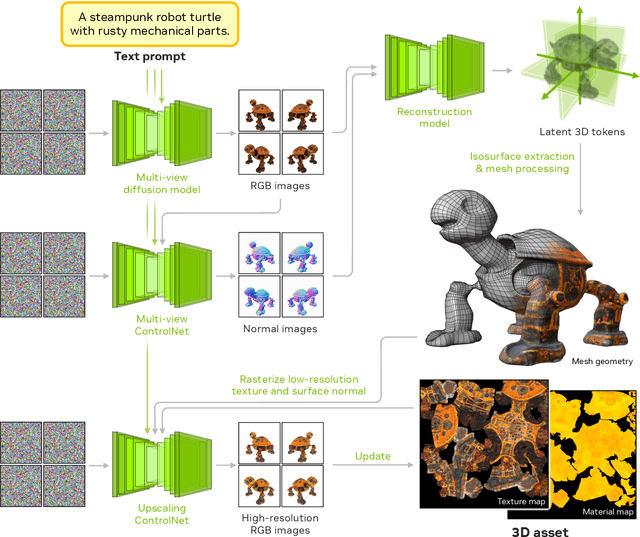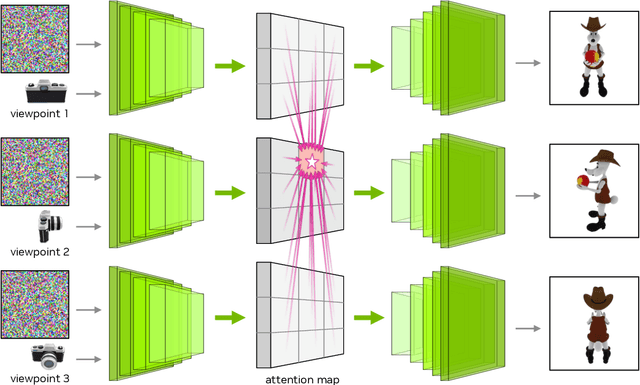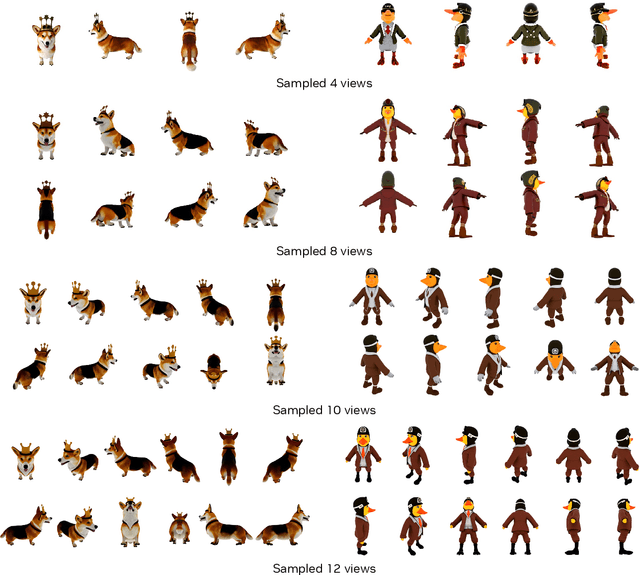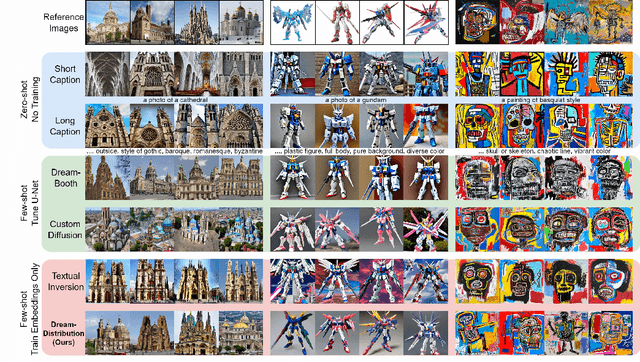Yunhao Ge
Scenethesis: A Language and Vision Agentic Framework for 3D Scene Generation
May 05, 2025Abstract:Synthesizing interactive 3D scenes from text is essential for gaming, virtual reality, and embodied AI. However, existing methods face several challenges. Learning-based approaches depend on small-scale indoor datasets, limiting the scene diversity and layout complexity. While large language models (LLMs) can leverage diverse text-domain knowledge, they struggle with spatial realism, often producing unnatural object placements that fail to respect common sense. Our key insight is that vision perception can bridge this gap by providing realistic spatial guidance that LLMs lack. To this end, we introduce Scenethesis, a training-free agentic framework that integrates LLM-based scene planning with vision-guided layout refinement. Given a text prompt, Scenethesis first employs an LLM to draft a coarse layout. A vision module then refines it by generating an image guidance and extracting scene structure to capture inter-object relations. Next, an optimization module iteratively enforces accurate pose alignment and physical plausibility, preventing artifacts like object penetration and instability. Finally, a judge module verifies spatial coherence. Comprehensive experiments show that Scenethesis generates diverse, realistic, and physically plausible 3D interactive scenes, making it valuable for virtual content creation, simulation environments, and embodied AI research.
Describe Anything: Detailed Localized Image and Video Captioning
Apr 22, 2025Abstract:Generating detailed and accurate descriptions for specific regions in images and videos remains a fundamental challenge for vision-language models. We introduce the Describe Anything Model (DAM), a model designed for detailed localized captioning (DLC). DAM preserves both local details and global context through two key innovations: a focal prompt, which ensures high-resolution encoding of targeted regions, and a localized vision backbone, which integrates precise localization with its broader context. To tackle the scarcity of high-quality DLC data, we propose a Semi-supervised learning (SSL)-based Data Pipeline (DLC-SDP). DLC-SDP starts with existing segmentation datasets and expands to unlabeled web images using SSL. We introduce DLC-Bench, a benchmark designed to evaluate DLC without relying on reference captions. DAM sets new state-of-the-art on 7 benchmarks spanning keyword-level, phrase-level, and detailed multi-sentence localized image and video captioning.
Cosmos-Transfer1: Conditional World Generation with Adaptive Multimodal Control
Mar 18, 2025Abstract:We introduce Cosmos-Transfer, a conditional world generation model that can generate world simulations based on multiple spatial control inputs of various modalities such as segmentation, depth, and edge. In the design, the spatial conditional scheme is adaptive and customizable. It allows weighting different conditional inputs differently at different spatial locations. This enables highly controllable world generation and finds use in various world-to-world transfer use cases, including Sim2Real. We conduct extensive evaluations to analyze the proposed model and demonstrate its applications for Physical AI, including robotics Sim2Real and autonomous vehicle data enrichment. We further demonstrate an inference scaling strategy to achieve real-time world generation with an NVIDIA GB200 NVL72 rack. To help accelerate research development in the field, we open-source our models and code at https://github.com/nvidia-cosmos/cosmos-transfer1.
Cosmos World Foundation Model Platform for Physical AI
Jan 07, 2025



Abstract:Physical AI needs to be trained digitally first. It needs a digital twin of itself, the policy model, and a digital twin of the world, the world model. In this paper, we present the Cosmos World Foundation Model Platform to help developers build customized world models for their Physical AI setups. We position a world foundation model as a general-purpose world model that can be fine-tuned into customized world models for downstream applications. Our platform covers a video curation pipeline, pre-trained world foundation models, examples of post-training of pre-trained world foundation models, and video tokenizers. To help Physical AI builders solve the most critical problems of our society, we make our platform open-source and our models open-weight with permissive licenses available via https://github.com/NVIDIA/Cosmos.
freePruner: A Training-free Approach for Large Multimodal Model Acceleration
Nov 23, 2024



Abstract:Large Multimodal Models (LMMs) have demonstrated impressive capabilities in visual-language tasks but face significant deployment challenges due to their high computational demands. While recent token reduction methods show promise for accelerating LMMs, they typically require extensive retraining or fine-tuning, making them impractical for many state-of-the-art models, especially those with proprietary training data. We propose freePruner, a training-free token reduction approach that can be directly applied to any open-source LMM without additional training. Unlike existing methods that rely heavily on token merging operations, freePruner employs a two-stage token selection strategy: (1) identifying pivotal tokens that capture high-level semantic information using our designed contribution degree metric, and (2) selecting complementary tokens that preserve essential low-level visual details through attention pattern analysis. Extensive experiments demonstrate that freePruner achieves 2x acceleration while maintaining comparable performance across mainstream visual question-answering benchmarks in the training-free setting. Moreover, freePruner is orthogonal to and can be combined with other post-training acceleration techniques, such as post-training quantization, providing a practical solution for efficient LMM deployment.
Edify Image: High-Quality Image Generation with Pixel Space Laplacian Diffusion Models
Nov 11, 2024Abstract:We introduce Edify Image, a family of diffusion models capable of generating photorealistic image content with pixel-perfect accuracy. Edify Image utilizes cascaded pixel-space diffusion models trained using a novel Laplacian diffusion process, in which image signals at different frequency bands are attenuated at varying rates. Edify Image supports a wide range of applications, including text-to-image synthesis, 4K upsampling, ControlNets, 360 HDR panorama generation, and finetuning for image customization.
Edify 3D: Scalable High-Quality 3D Asset Generation
Nov 11, 2024



Abstract:We introduce Edify 3D, an advanced solution designed for high-quality 3D asset generation. Our method first synthesizes RGB and surface normal images of the described object at multiple viewpoints using a diffusion model. The multi-view observations are then used to reconstruct the shape, texture, and PBR materials of the object. Our method can generate high-quality 3D assets with detailed geometry, clean shape topologies, high-resolution textures, and materials within 2 minutes of runtime.
BEHAVIOR Vision Suite: Customizable Dataset Generation via Simulation
May 15, 2024



Abstract:The systematic evaluation and understanding of computer vision models under varying conditions require large amounts of data with comprehensive and customized labels, which real-world vision datasets rarely satisfy. While current synthetic data generators offer a promising alternative, particularly for embodied AI tasks, they often fall short for computer vision tasks due to low asset and rendering quality, limited diversity, and unrealistic physical properties. We introduce the BEHAVIOR Vision Suite (BVS), a set of tools and assets to generate fully customized synthetic data for systematic evaluation of computer vision models, based on the newly developed embodied AI benchmark, BEHAVIOR-1K. BVS supports a large number of adjustable parameters at the scene level (e.g., lighting, object placement), the object level (e.g., joint configuration, attributes such as "filled" and "folded"), and the camera level (e.g., field of view, focal length). Researchers can arbitrarily vary these parameters during data generation to perform controlled experiments. We showcase three example application scenarios: systematically evaluating the robustness of models across different continuous axes of domain shift, evaluating scene understanding models on the same set of images, and training and evaluating simulation-to-real transfer for a novel vision task: unary and binary state prediction. Project website: https://behavior-vision-suite.github.io/
Visual Fact Checker: Enabling High-Fidelity Detailed Caption Generation
Apr 30, 2024



Abstract:Existing automatic captioning methods for visual content face challenges such as lack of detail, content hallucination, and poor instruction following. In this work, we propose VisualFactChecker (VFC), a flexible training-free pipeline that generates high-fidelity and detailed captions for both 2D images and 3D objects. VFC consists of three steps: 1) proposal, where image-to-text captioning models propose multiple initial captions; 2) verification, where a large language model (LLM) utilizes tools such as object detection and VQA models to fact-check proposed captions; 3) captioning, where an LLM generates the final caption by summarizing caption proposals and the fact check verification results. In this step, VFC can flexibly generate captions in various styles following complex instructions. We conduct comprehensive captioning evaluations using four metrics: 1) CLIP-Score for image-text similarity; 2) CLIP-Image-Score for measuring the image-image similarity between the original and the reconstructed image generated by a text-to-image model using the caption. 3) human study on Amazon Mechanical Turk; 4) GPT-4V for fine-grained evaluation. Evaluation results show that VFC outperforms state-of-the-art open-sourced captioning methods for 2D images on the COCO dataset and 3D assets on the Objaverse dataset. Our study demonstrates that by combining open-source models into a pipeline, we can attain captioning capability comparable to proprietary models such as GPT-4V, despite being over 10x smaller in model size.
DreamDistribution: Prompt Distribution Learning for Text-to-Image Diffusion Models
Dec 21, 2023



Abstract:The popularization of Text-to-Image (T2I) diffusion models enables the generation of high-quality images from text descriptions. However, generating diverse customized images with reference visual attributes remains challenging. This work focuses on personalizing T2I diffusion models at a more abstract concept or category level, adapting commonalities from a set of reference images while creating new instances with sufficient variations. We introduce a solution that allows a pretrained T2I diffusion model to learn a set of soft prompts, enabling the generation of novel images by sampling prompts from the learned distribution. These prompts offer text-guided editing capabilities and additional flexibility in controlling variation and mixing between multiple distributions. We also show the adaptability of the learned prompt distribution to other tasks, such as text-to-3D. Finally we demonstrate effectiveness of our approach through quantitative analysis including automatic evaluation and human assessment. Project website: https://briannlongzhao.github.io/DreamDistribution
 Add to Chrome
Add to Chrome Add to Firefox
Add to Firefox Add to Edge
Add to Edge